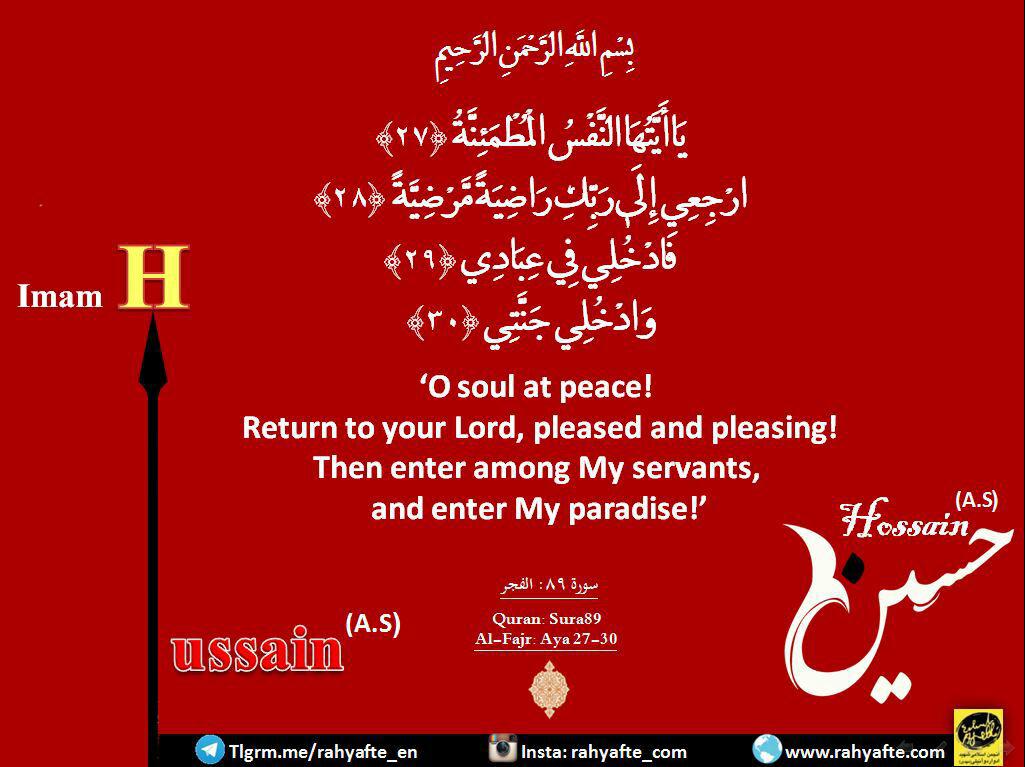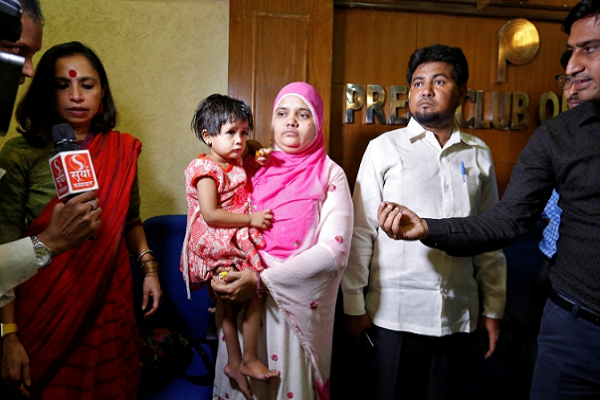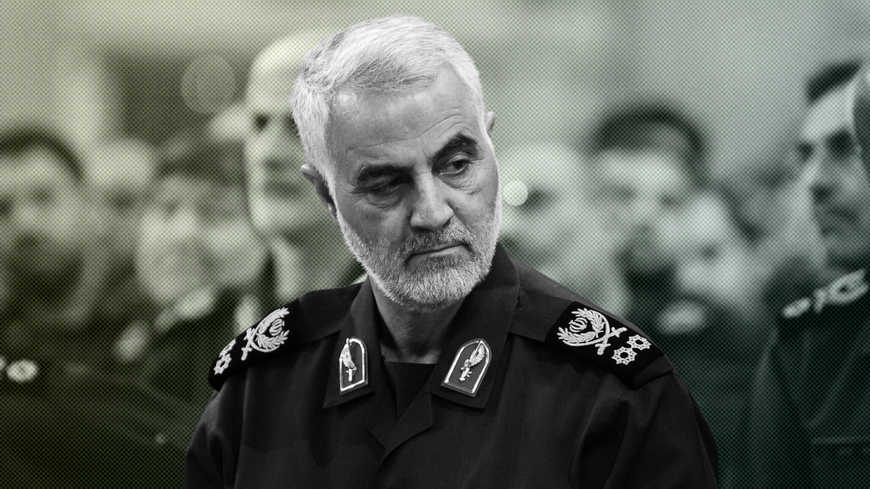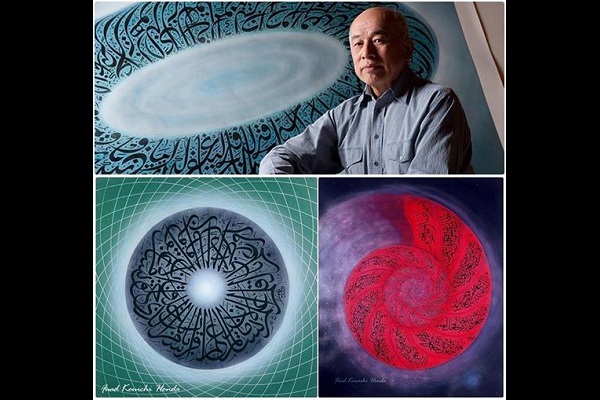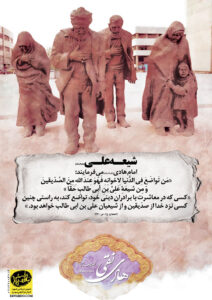According to rahyafte (the missionaries and converts website): ʿIlm al-rijāl is a branch of learning that deals with the biographies of the narrators of ḥadīth, particularly with regards to their reliability as sources. A working knowledge of rijāl is generally expected from every jurist as if he wants to give legal edicts on the basis of a tradition he must first determine its authenticity and reliability. Therefore, Shīʿa Jurists endeavored to expand this knowledge. Some of the founders of this science are as follows:
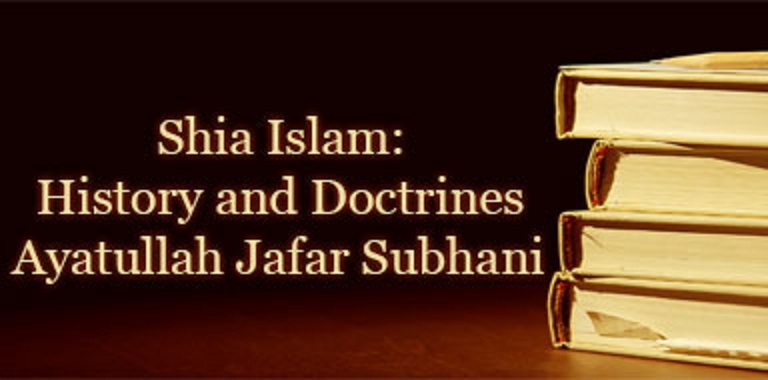
1. ʿAbd Allāh b. Jabala Kinānī (d. 219 AH): Najāshī says that the family of Jabala is well-known in Kufa and he is a reliable and famous jurist. He has a book entitled al-Rijāl (Najāshī, no. 561).
2. ʿAlī b. Ḥasan b. Faḍḍāl: He is a famous jurist from Kufa, a reliable narrator and knowledgable in the science of ḥadīth. He is a companion of the Imams al-Hādī and al-ʿAskarī and the author of several books. One of his books is al-Rijāl. (Ibid., 674)
Whenever historians mention Ibn Faḍḍāl the junior, they mean ʿAlī b. Ḥasan and by Ibn Faḍḍāl the senior, they mean his father Ḥasan b. Faḍḍāl.
3. Ḥasan b. Maḥbūb al-Sarrād (150-224) was a master of ḥadīth and narrated from sixty other masters of ḥadīth. He was a companion of Imam al-Sādiq and has two books on rijāl, namely Maʿrifat Ruwāt al-Akhbār and al-Mashyakha.
4. Muḥammad b. ʿUmar b. ʿAbd al-ʿAzīz al-Kashshī: He was a famous biographer, trined in the school al-ʿAyyāshī. He has a book entitled Maʿrifat al-Rijāl, which discusses the identity of the narrators who have narrated ḥadīth from the Imams. The original book is no longer extant but al-Ṭūsī has condensed it into his Ikhtiyār Maʿrifat al-Rijāl. (Ibid., no. 1018)
5. Aḥmad b. ʿAlī al-Najāshī (372-450): He is considered a prominent Shīʿa scholar in the science of rijāl and in this science is second to none. His book of Rijāl is actually a comprehensive bibliography of Shīʿa books and is at the same time one of the most seminal records of Shīʿa scholars. The book is recently published by the Imam Sādiq Institute in two elegant volumes.
6. Shaykh al-Ṭūsī (385-460): His intellectual stature is so great that it cannot be described in this short space. He was an authority in numerous Islamic sciences and contributed to almost every field of learning. His two biographical books, al-Rijāl and al-Fihrist, are among the most relied-upon documents for identifying narrators of ḥadīth, each of which written in a particular way: In his Rijāl, Ṭūsī lists the narrators of ḥadīth from the time of the Prophet until after the Lesser Occultation in alphabetical order in 14 generations.
On the other hand, his Fihrist is practically a bibliography of Islamic sciences arranged according to the authors and in many cases the author presents his evidence on a given title helping us to determine the reliability of the narrtors and whether or not to act according to that saying.
These are just some of the books written on rijāl. It is noteworthy that those who are against the Household of the Prophet but cannot direct their enmity towards them on them instead direct it to the followers of the Prophet’s Household. In doing so, they constanly resort to lies and false-accusations; Ibn Taymiyyah is the first who accused Shīʿa of having few works on ḥadīth and rijāl. Following him, another writer by the name of Marʿashī essentially denied the existence of the sciences of ḥadīth and rijāl in the Shīʿa tradition. Recently, ʿAbd al-Raḥmān Sāliḥī, in the preface to a book entitled Masādir al-Talaqqī, has asserted that the Shīʿa in the Fourth and Fifth Centuries have fabricated the collections of their traditions. It sounds as though Shīʿa were an obscure community who could have fabricated thousands of aḥadīth without anyone noticing!
Ayatullāh Jaʿfar Subḥānī responded to this by writing a letter to the author saying that we have access to books written in the Second and Third Centuries. Is it really possible to say that these books were fabricated in the following centuries? Furthermore, in order to remove doubt and to prevent the repetition of this accusation he wrote a book entitled Dawr al-Shīʿa fī al-Ḥadīth Nashaʾtan wa Tatawwuran and sent it with a letter through the Ambassador of Iran in Riyadh to ʿAbd al-Raḥmān Ṣāliḥī. From this experience we have learnt that everything comes to an end except the fabrication of lies about Shīʿa and everything has a cause behind it except for people’s enmity towards the Shīʿa!
The Rational Sciences
One of the highest goals of Islam is to free people’s minds from baseless ideas and to encourage them to use their reason. This is why the word ʿaql (reason) and its derivatives appears forty-seven times in the Qurʾān, the word tafakkur (to think) eighteen times, the word lubb (intellect) sixteen, and the word tadabbur (contemplation) four. Islam invites man to study the created world and, when reasoning for the existence of God, provides the best argument with these short sentences:
‘Were they created from nothing? Or are they [their own] creators? Did they create the heavens and the earth? Rather they have no certainty!’(Q52:35-36)
Although the approach of Islam is to invite people to rational thinking, unfortunately a group of Muslims, instead of contemplating about the great knowledge inherent in the Qur’an and ḥadīth, allowed themselves to be deceived by Judeo-Christian interpolations and followed the method of anthropomorphism when it came to God and thus deprived themselves of rational thinking. Shahristānī says that some of these shallow people believe God to possess all human body parts except the beard and the private parts, saying: ‘Please don’t ask me about the beard and the private parts – ask about other things!’ (al-Milal wa al-Niḥal, 1/105)
The influx of Judeo-Christian ideas led a great number of narrators in the Second and Third Centuries to resort to anthropomorphism in their ideas about God. Others who were unwilling to follow this approach found an alternative by claiming that man cannot comprehend metaphysical issues.
However, this is clearly not true. We can discuss metaphysical realities and access their realm. Of course, this is not done intuitevely but rationally. It is possible via two approaches:
First, a deep and careful investigation of nature, whose secrets and laws lead us to the glory and perfection of the Creator.
Syllogistic reasoning, that is when the minor and major premises are absolute, they will inevitably lead us to absolute conclusions. This is the method ʿAlī and other the Imams adopted. To illustrate this point, we content ourselves with an example:
Someone asked Imam ʿAlī, ‘Can God put the whole world into an egg, without making the world smaller or making the egg larger?’ the Imam answered: ‘Weakness or inability are not characteristics which can be attributed to God, but what you have asked is something which is not possible to come into existence.’
Pondering over the above question and answer help us to see the point that the the Imam has reasoned by using the proper syllogism for this question; namely the principle of non-contradiction means that the container must always be larger than what it contains. If the whole world can be put in an egg without the world becoming smaller or the egg bigger, we will conclude that the contents are larger than the container. This is impossible because the first premise (‘a continer must always be larger than its contents’) is absolute, and so surely its opposite (‘the contents can be larger than the container’) is definitely nullified.
The sermons of ʿAlī in The Nahj al-Balāgha serve as the foundation for Shīʿa theology and philosophy. These sermons have shaped Shīʿa ideas over many centuries. Thus, in the school of The Prophet’s Family, many eminent theologians were trained. Some of these are as follows:
Shīʿa Theologians in the Second Century
1. Zurara b. Aʿyan: An outstanding scholar of his time, an expert theologian and a great poet. God blessed him with a number of virtues: knowledge, faith and truthfulness in speech. Shaykh al-Ṣadūq says he has seen a book by him entitled al-Istiṭāʿa wa al- Jabr. (Najāshī, 397; Ṭūsī, Fihrist, 314; Mizān al-Iʿtidāl, 2/2853) Ibn al-Nadīm says that he was one of the greatest Shīʿa scholars in Islamic jurisprudence, science of ḥadīth, and theology. (Fihrist, 323)
2. Muḥammad b. ʿAlī b. Nu’man: He was a distinguished theologian whose opponents, because of his fierce debates, called him Shayṭān al-Ṭāq (‘the Unique Devil’). He was matchless theology and eloquence. Najāshī says that he had a book entitled Afʿal wa la Tafʿal that he saw in the possession of Aḥmad b. Ḥusayn b. ʿAbd Allāh al-Ghaḍāʾirī, which was a substantial work. He has another book entitled al-Iḥtijāj on the proofs for the Imamate of ʿAlī, and a third one about his debates with Abū Ḥanīfa and the Murjiʾa. The year of his death is unknown but as Imam al-Sādiq passed away in 148 AH and Abū Ḥanīfa died in 150 AH, we can conclude that he lived in the same era as they did. Ibn al-Nadīm is familiar with him and says he was an expert theologian and has the following books to his name: Kitāb al-Imāma, Kitāb al-Maʿrifa, Kitāb al-Radd ʿalā al-Muʿtazila fī Imāmat al-Mafḍūl, Kitāb fī Amr Ṭalḥa wa al-Zubayr wa ʿĀʾisha. (Ibn al-Nadīm, Fihrist, p. 257; Ṭūsī, Fihrist, 258, 264)
3. Hishām b. Ḥakam: Ibn al-Nadīm says that he was an outstanding Shīʿa theologian. He is the one Imam al-Sādiq prayed for and said to him the very sentence that The Messenger of God said about Ḥasan b. Thābit: ‘May the Holy Spirit help you as long as you support us with your tongue.’ He was the first to analyze the issue of the Imamate in theology and paved the way for rationalization. He was an ingenious and witty debator.
Shahrastānī says: ‘ Hishām b. Ḥakam was an adept scholar in theology and his debates against the Muʿtazila are not to be overlooked. (al-Milal wa al-Niḥal, 1/185)
Najāshī says that in his last days Hishām moved from Kufa to Baghdad and died in 199 AH then he mentions the titles of his books and counts up to 30 titles, most of them in theology. (Najāshī, no. 1165)
Aḥmad Amīn says that Hishām was one of the prominent Shīʿa theologians, was vigorous in debates and had some debates with the Muʿtazila. Numerous debates of his are quoted in literature books and these demonstrate his presence of mind when answering questions.
In his youth, Hishām b. Ḥakam followed Abū Shākir al-Daysānī who held mistaken ideas in religion. Then he left him and joined Jahm b. Ṣafwān, who was killed in Tirmidh in 128 AH. Then fate led him to Imam al-Sādiq and he embraced Imamī doctrines and studied the teachings of the Prophet’s Household. If false ideas are quoted from Hishām, they have to do with his youth when he was associating with Abū Shākir and Jahm b. Ṣafwān. However, after joining Imam al-Sādiq his ideas changed and he became a stalwart defender of the latter’s teachings. The late Shaykh ʿAbd Allāh Niʿma, one of Lebanon’s preeminent scholars, has written a book on the life of Hishām b. Ḥakam and saved us from further elaborations.
Nowadays there are people in our community who, due to a number of misconceptions, prevent people from rational, philosophical and even theological reasoning and suppose that the right path is to consult verses and traditions and not to make use of rational sciences. This is wrong from several points of view. We content ourselves to quote a ḥadīth to make it clear that our infallible leaders trained theologians in their circles. Kulayni narrates that a man came from Syria to see Imam al-Sādiq and debate with his students. The Imam orderd Yūnis b. Yaʿqūb to see if any of his distinguished students in theology were nearby. Yūnis said, ‘I went out and visited their homes, first I brought Zurāra who was an expert in theology, then I fetched Muʾmin al-Ṭāq who also had a comprehensive knowledge of this science, then Hishām b. Ḥakam, then Qays b. Māṣir, who I personally regarded as the most learned of Imam al-Sādiq’s Companions in theology who had studied under ʿAlī b. Ḥusayn. I brought them all to the presence of the Imam. (Kāfī, 1/171; Najāshī, no. 794)
4. Qays al-Māṣir: A great scholar of theology whose principles he learned from Imam ʿAlī b. al-Ḥusayn. We have already quoted what Yūnis b. Yaʿqūb said about him.
5. ʿĪsā b. Rawḍa: He was Manṣūr’s chamberlain, an expert theologian, and an eloquent speaker. Aḥmad b. Abī Ṭāhir in his book, Baghdād, says that he had seen a book of his on the Imamate. Najāshī says that some of our scholars have also seen that book and I have read: ‘when Manṣūr arrived in Kufa, he secretly attended his classes as he was talking about the Imamate and he approved of his ideas. The year of his death is unknown, however, Manṣūr passed away in 158 AH, so he must certainly belong to the theologians of the second century.
6. Abū Mālik Ḍaḥḥāk al-Ḥaḍramī: He was from Kufa and lived during the time of Imam al-Sādiq. Some say that he has narrated from that the Imam, however it is certain that he has at the very least narrated from Imam Mūsā al-Kāẓim. Najāshī says: ‘he was a theologian and a reliable narrator of traditions. He has a book on tawḥīd that ʿAlī b. Ḥasan Ṭaṭarī narrates from.’ For that reason, he belongs to the theologians of the second century. (Najāshī, no. 544) Ibn al-Nadīm regards him as a Shīʿa theologian and says: ‘he debated in one meeting with Abū ʿAlī Jubbāʾī about the Imamate and proved his ideas in support of the Imamate in presence of Abū Muḥammad Qāsim b. Muḥammad al-Kūfī. He has a book on the Imamate and another unfinished book in which he responds to Abū ʿAlī Jubbāʾī’s own book on the Imamate, refuting his ideas on that issue. (Fihrist, 266)
7. ʿAlī b. Ḥasan b. Muḥammad al-Ṭāʾī, popularly known as Ṭāṭarī: He is a reliable jurist, scholar of ḥadīth, and author of books about tawḥīd, Imamate, human nature (fiṭra), knowledge and guardianship (wilāya). (Najāshī, no. 655) Ibn al-Nadīm considers him An Imāmī theologian and says, ‘Tāṭarī is a Shīʿa theologian. He has a book about the Imamate that is very fine.’ As one of the companions of Imam al-Kāẓim, he certainly belongs to the theologians of the second century.
8. Ḥasan b. ʿAlī b. Yaqtin b. Mūsā: He is a theologian and a jurist who has narrated traditions from the two Imams al-Kāẓim and al-Riḍā. He has a book entitled Masāʾil Abī al-Ḥasan Mūsā. (Ibid., no. 9)
Since Imam al-Kāẓim passed away in the year 183 AH and Imam al-Riḍā in the year 203 AH, he certainly belongs to the theologians of the second and early third century. Even Shaykh in his Rijāl has counted him among the companions of Imam al-Riḍā. (Rijāl, no. 7)
Once he asked the eighth the Imam (A.S), ‘I cannot enjoy your presence all the time, from whom can I learn my creed?’ ‘From Yūnus b. ʿAbd al-Raḥmān,’said the Imam. (Najāshī, no. 1209)
9. Hādīd b. Hakīm, known as Abū ʿAlī al-Azadī al-Madāʾinī: He is a reliable narrator and a well-known theologian. He has narrated traditions from Imams al-Sādiq and al-Kāẓim, and Muḥammad b. Khālid has narrated from him. (Ibid., no. 383; Khaṭīb has mentioned him in Tārīkh Baghdād, no. 4377) Therefore he belongs to the theologians of the second century.
10. Faḍḍāl b. Ḥasan b. Faḍḍāl: He was a theologian of Imam al-Sādiq’s time. Ṭabarsī has quoted his debate with Abū Ḥanīfa in his book al-Iḥtijāj.
The theologians we have mentioned here are of the time of Imam al-Sādiq and al-Kāẓim. These figures had debates with their opponents which are recorded in history books. Other names that belong to this list are Ḥumrān b. Aʿyān al-Shaybānī, Hishām b. Sālim al-Jawlaqī, Sayyid Ḥimyarī and Kumayt al-Asadī. (Aʿyān al-Shīʿa.,Vol.1, pp. 134-35)
Shīʿa theologians of the Third Century
In the Third Century, ingenious theologians who were mostly the students of Imam al-Hādī and al-ʿAskarī appeared amongst the Shīʿa. Now we shall enumerate some of these:
1. al-Faḍl b. Shādhān: He is AbūMuḥammad al-Faḍl b. Shādhān b. Khalīl al-Azadī al-Nīshābūrī. His father was among the companions of Yūnis b. ʿAbd al-Raḥmān. He himself has narrated from Imam al-Jawād. It is believed that he has even narrated some ḥadīth from Imam al-Riḍā.
Faḍl b. Shādhān was an eminent Islamic jurist and theologian of his time whose greatness is beyond description. Ganjī Shāfiʿī says that he wrote as many as one hundred and eighty books. Ṭūsī in his Rijāl considers him among the Companions of Imam al-Hādī and al-ʿAskarī and believes he died in 260 AH. Najāshī, Ṭūsī and Kashshī have given us some titles of these books. (see Najāshī, no. 838 ; Ṭūsī, Rijāl, no. 1 & 2 ; and Kashshī, Rijāl, no. 416).
Merely the titles that Najāshī names reveal that Faḍl b. Shādhān had been actively involved in debates defending Shi’ism and Islam, therefore the majority of his books consist of rebuttals.
2. Ḥakam b. Hishām b. Ḥakam: He was the son of famous Hishām mentioned above, a resident of Basra, and an expert in theology. Najāshī says that some of our scholars have seen his book on the Imamate. (Najāshī, no. 349) As his father died in the year 199 AH or 200 AH, he is to belong to the theologians of the early Third Century.
3. Dāwūd b. Asad b. Aʿfar, popularly known as Abū al-Aḥwaṣ al-Miṣrī, was a great teacher, jurist, theologian and a reliable narrator. His father was among the narrators of ḥadīth and a reliable narrator himself. Dāwūd b. Asad compiled several books, one of which is on the Imamate. (Ibid., no. 412) Shaykh al-Ṭūsī mentions in the Fihrist that he is of the Imāmiyya theologians and Ḥasan b. Mūsā al-Nawbakhtī has attended his discussions and studied under him. As Ḥasan b. Mūsā al-Nawbakhtī is a contemporary of Jubbāʾī (d. 303 AH), we may conclude that Dāwūdb. Aasd belongs to the theologians of the Third Century.
4. Muḥammad b. ʿAbd Allāh b. Mumallik al-Iṣfahānī: He was originally from Jurjan but settled in Isfahan. He was a great scholar of his day; he initially followed the Muʿtazila for a while before coming to Shi’ism under the guidance of the Shīʿa scholar, ʿAbd al-Raḥmān b. Ahmad Jabrawayh. He has several books in theology such as al-Jamiʿ fī Sāʾir Abwāb al-Kalām, al-Masāʾil wa Jawābāt fī al-Imāma, Mawalīd al-Aʾimma and records of his debates with Abū ʿAlī Jubbāʾī. (Najāshī, no. 1034)
5. Thābit b. Muḥammad, known as AbūMuḥammad al-ʿAskarī: He was a colleague of Abū ʿĪsā Warrāq, an expert theologian, and a companion of Imam al-Hādī. He had a vast knowledge of ḥadīth and Jurisprudence. Among his theological works we can name Naqḍ al-ʿUthmāniyyah and Dalāʾil al-Āʾimma. Since Abū ʿĪsā passed away in 247 AH Thābit b. Muḥammad must belong to the theologians of the Third Century.
6. Ismāʿīl b. Muḥammad b. Ismāʿīl b. Hilāl al-Makhzūmī: A scholar of the Imāmiyya, Ayūb b. Nūḥ, Ḥasan b. Muʿāwiya, Muḥammad b. Ḥusayn and ʿAlī b. Ḥasan b. Faḍḍāl narrated traditions from him. He has a book on tawḥīd, another on knowledge and a third one on the Imamate. As his student, Ḥasan b. ʿAlī b. Faḍḍāl was a companion of Imam al-Hādī and al-ʿAskarī, he too must belong to the theologians of the Third Century.
7. Muḥammad b. Harūn: Popularly known as Abū ʿIsā Warrāq, he is the author of books such as al-Imāma, al-Saqīfa, Ikhtilāf al-Shīʿa and al-Maqālāt. Ibn Ḥajar reports that he wrote works based on Muʿtazilī doctrines but Masʿūdī says that he has written some fine books on the Imamate and other issues. He passed away in 247 AH. (Najāshī, no. 1017; Lisān al-Mīzān vol. 5, no. 1360; Rawāshīh Samāwiyya, p. 55) Ibn Ḥajar includes him among the Muʿtazila because he often confuses them with Twelvers and has included some Twelver scholars among the Muʿtazila.
8. Ibrāhīm b. Sulaymān b. Abī Dāḥa al-Mazanī: One of the foremost scholars of Basra, their leader in matters of jurisprudence, theology, and poetry, to the extent that Jāḥiẓ (d. 255 AH) narrates from him. He says: Ibrāhīm b. Abī Dāḥa narrated for that Muḥammad b. Abī ʿUmayr passed away in 217 AH. (Bayān, 1/61) Based on this fact, and the fact that Jāḥiẓ narrates from him, he definitely belongs to the theologians of the Third Century.
9. Shakkāl: Ibn al-Nadīm says that he was a close friend of Hishām b. Ḥakam and while they disagreed over some issues, they were of the same mind regarding the issue of the Imamate. Some of his books include (1) Kitāb al-Maʿrifa, (2) Kitāb fī al-Istitāʿa, (3) Kitāb al-Imāma, (4) Kitāb ʿalā Man Abā Wujūb al-Imāma Bi al-Naṣṣ. (Ibn al-Nadīm, Al-Fihrist, p. 264) As Hishām b. Ḥakam passed away at the end of the second century, Shakkāl mush have died at the end of the second or the beginning of the third century.
10. Ḥusayn b. Ashkīb: In his Rijāl, Kashshī includes him amongst the companions of Imam al-Hādī and says that he was a theologian, who authored some books and resided in Samarkand and Kashsh. One of his books refutes the idea that the Prophet believed in the religion of the Quraysh before he began his mission. He has also refuted the beliefs of Zaydiyya in another. As he is a companion of Imam al-Hādī who passed away in 254 AH, he belongs to the theologians of the Third Century. (Najāshī, no. 87) Shaykh al-Ṭūsī also included him among the Companions of Imam al-Hādī. (Ibid., 623)
11. ʿAbd al-Raḥmān b. Aḥmad b. Jabrawayh: An expert theologian, a skillful author and an eloquent speaker. It was through contact with him that Muḥammad b. ʿAbd Allāh b. Mumallik al-Iṣfahānī gave up the creed of the Muʿtazila and embraced that of the Imāmiyya. He had a debate with ʿAbād b. Sulaymān. Najāshī reports that his al-Kāmil fī al-Imāma is his only book available to us. Because Ibn Mumallik is contemporary with Jubāʾī, who died in 303AH, he should naturally belong to the theologians of the Third and the early Fourth Century.
12. ʿAlī b. Manṣūr: He lived in Baghdad and was among the followers of Hishām b. Ḥakam. He wrote several books in theology. Some of them, like al-Tadbīr fī al-Tawḥīd and al-Imāma are well-known. (Najāshī, no. 656) As Hishām b. Ḥakam passed away at the end of the Second Century, his student ʿAlī b. Manṣūr would belong to the Third Century.
13. ʿAlī b. Ismāʿīl b. Shuʿayb b. Maytham: He lived in Basra and was among the leading Shīʿa theologians. He had some debates and scholarly exchanges with the Muʿtazilī Abū Hudhayl Allāf (135-235 A.H) and Naẓẓām (160-201). Among his books we can name al-Imāma, Majālis Hishām b. Ḥakam (probably containing the debates of Hishām) and a work on temporary marriage.
Ibn al-Nadīm says that the first person who spoke about the Imamate was ʿAlī b. Ismāʿīl whose grandfather was Maytham al-Tammār, one of the companions of ʿAlī. ʿAlī b. Ismāʿīl has a book about the Imamate entitled al-Imāma and another book under the title of al-Istiḥqāq.
Shīʿa Theologians of the Fourth Century
1. Ḥasan b. ʿAlī b. Abī ʿAqīl, also known as Abū Muḥammad, was a prominent Islamic jurist and a trusted theologian who wrote a few works, the most famous of which is al-Mutamassik bi ḥabl Āl al-Rasūl. (Najāshī)
2. Ismāʿīl b. Abī Sahl b. Nawbakht was a masterful theologian of his own time who wrote a few works, including al-Istīfāʾ fī al-Imāma and al-Tanbīh fī al-Imāma. According to Ibn Nadīm, Ismāʿīl was a renowned Shīʿa scholar and Abū al-Ḥasan al-Nāshī refers to him as his teacher and as a very knowledgeable and prominent theologian. Nāshī gives a list of Ismāʿīl’s works and reports that he had discussions with some other theologians.
3. Ḥusayn b. ʿAlī b. Babwayh is Shaykh al-Ṣadūq’s brother who acquired the permission to narrate aḥādīth from their father. It is said that Ḥusayn and his brother were born as a result of Imam al-Mahdī’s supplication. Ibn Ḥajar has provided a biography of Ḥusayn in Lisān al-Mīzān. (Najāshī, Ibn al-Nadīm, Lisān al-Mīzān)
4. Muḥammad b. Bishr al-Ḥamdūnī, typically known as Abū al-Ḥasan al-Sūsanjurdī, was devoted follower of the Prophet’s Household who composed a few works, including al-Muqniʿ fī al-Imāma and al-Munqidh fī al-Imāma. (Najāshī) According to Ibn al-Nadīm, Susanjurdī was a pupil of Abū Sahl al-Nawbakhtī, and was sometimes referred to as Ḥamdūni because of his association with the Ḥamdūn tribe. He wrote a book entitled al-Inqādh fī al-Imāma. Ibn Ḥajar describes him as a pious and austere Shīʿa theologian who has written works confirming his Shīʿa beliefs. (Ibn al-Nadīm)
5. Abū Muḥammad Yaḥyā al-ʿAlawī, a member of the Banū Zubara, was a theologian and jurist of Nīshābūr. In his Fihrist, Shaykh al-Ṭūsī describes him as a capable theologian and pious believer. He authored Ibṭāl al-Qiyās and al-Tawḥīd. (Najāshī; Ṭūsī, Fihrist)
6. Muḥammad b. ʿAbd al-Raḥmān (Abū Jaʿfar), also known as Ibn Qiba al-Rāzī, was a masterful theologian who wrote a book on theology. In his Fihrist, Ibn Baṭṭa reports to have studied traditions under Ibn Qiba. According to Ibn al-Nadīm, Abū Jaʿfar was an erudite Shīʿa theologian who wrote, among other books, al-Inṣāf fī al-Imāma and Kitāb al-Imāma. (Fihrist) ʿAllāmah, in his Khulāṣah, refers to Ibn Qiba as a skillful Shīʿa scholar of his own day.
7. Abū al-Ḥasan Nāshī (271-365 AH), whose real name is ʿAlī b. Waṣīf, has been introduced by Najāshī as a poet and a theologian. According to Mufīd, as Najāshī reports, Nāshī has a book on the Imamate. Shaykh al-Ṭūsī refers to him as capable poet and a skillful theologian with a few books. (Fihrist)
According to Ibn Khalikān, ‘Nāshī was as an adherent of the Shīʿī Imams who composed some poems in praise of these the Imams. He learned theology from Abū Sahl Ismāʿīl b. ʿAlī b. Nawbakht and is considered a great Shīʿa thinker with some works.’ Ibn Kathīr says, ‘Nashi is a preeminent Shīʿa thinker.’ Therefore, he is a Fourth Century theologian. (Tanqīḥ al-Maqāl)
8. Ḥasan b. Mūsā, known as Abū Muḥammad Nawbakhtī, was an eminent scholar who flourished at around the turn of the Fourth Century. He wrote a few works refuting some ideas of the previous philosophers and theologians, including: 1) al-Arāʾ wa al-Diyānāt, about which Najāshī says, ‘It is a great work containing excellent knowledge of various sorts. I studied the book with my teacher Shaykh al-Mufīd’; 2) Firaq al-Shīʿa; 3) al-Radd ʿalā Firaq al-Shīʿa mā Khalā al-Imāmiyya and 4) al-Jāmiʿ fī al-Imāmiyya. Ibn Nadīm speaks very well of Ḥasan b. Mūsā, which shows that he was a prominent theologian of the Fourth Century and a contemporary of Jubāʾī (d. 303 AH) and Balkhī (d. 319 AH).
9. Shaykh al-Mufīd (336-413 AH) was the greatest theologian of the Fourth Century who was widely known in the world of that age and has left us a good number of valuable works. Ibn Nadīm, a contemporary of Mufīd, says of him, ‘Ibn al-Muʿallim, the leading theologian of our age, is most skillful in theology and very intelligent with a strong memory. I have seen him myself: he is an able theologian.’ (Fihrist)
Ibn al-Jawzī writes, ‘He is a leader of the Shīʿa and a leading theologian who has several works on the Shīʿa. Murtaḍā is one of his followers. Ibn al-Muʿallim used to hold courses at his residence in Darb Rabāḥ where all scholars used to gather. The Buyid rulers liked him very much because they were his followers. (al-Muntaẓam)
Yāfiʿī (768 AH) writes: ‘In 413 AH, the senior Shīʿa scholar and author of a large number of books, Shaykh al-Mufīd, passed away. He was also known as Ibn al-Muʿallim. He was a prominent figure in theology, scholarly debate and jurisprudence. He used to have discussions with followers of all faiths. He was highly respected by the Buyid government. Ibn Abī Tayy says: ‘He used to donate frequently. He was very humble. He never missed his prayers or fasting. He was attired in casual and coarse dress.’ Another one days: ‘ʿAḍd ad-Dawla Daylamī used to visit Shaykh al-Mufīd on many occasions. The Shaykh was someone of medium stature, thin and with a light complexion. He lived for 76 years and authored more than 200 books. Some 80,000 Shīʿa and Rāfiḍa were reported to have attended his funeral.’ (Mirʾāt al-Jinān)
Abū al-Fidāʾ b. Kathīr (d. 774 AH), praises him as follows: ‘He was the leader of the Imāmiyya and Shīʿa, a prominent author of theirs and the guardian of their territory. A large number of scholars of different faiths used to attend his courses.’ (al-Bidāya wa al-Nihāya)
Dhahabī (d. 748 AH) says: ‘He was a Shīʿa scholar and the leader of the Rāfiḍa. He authored many books. Ibn Abī Tayy mentions in his Tārīkh al-Imāmiyya that he was the teacher all Shīʿa scholars and their spokesperson. . He was a prominent figure in theology, scholarly debate and jurisprudence. He used to have discussions with followers of all faiths. He was highly respected by the Buyid government.’ (al-ʿIbra)
Ibn Ḥajar writes: ‘He was humble and he used to extend his prayers. He was always looking into scholarly issues. A large number of people learned from him. In the eyes of the Imāmiyya, he was very capable. The Shīʿa owe much to him. His father was a teacher in Wasit. Mufīd used to sleep for a few hours before getting up and resuming his studies, prayers and recitation of the Qurʾān.’ (Lisān al-Mīzān)
Now, let us hear what two students of Shaykh al-Mufīd have to say; Shaykh al-Ṭūsī (385-460 AH) writes in his Fihrist: Shaykh al-Mufīd, better known as Ibn al-Muʿallim, is a theologian of the Imāmiyya. He became the head of the sect and was a prominent theologian. He was a high-ranking and assiduous scholar who had good memory and was always ready to respond. He wrote 200 books of varying size the list of his works is well known. He was born in 338 AH and passed way in 413 AH. The day of his departure was a historic occasion. Never had Baghdad seen such a mournful day.’ Najāshī (372-450 AH), says: ‘The position of Shaykh al-Mufīd, the great scholar, is beyond description in words.’
We have briefly reviewed the most prominent Shīʿa theologians of the Fourth Century. Those who would like to learn more about Shīʿa scholars throughout 14 centuries can refer to Ṭabaqāt al-Mutakallimīn, printed in five volumes by the Imam Sādiq Institute.
Now we will review some of the prominent philosophers from the Fourth Century onwards:
1. Fārābī (260-339 AH): Muḥammad b. Ṭarakhān, or Muḥammad b. Aḥmad b. Ṭarakhān, carried the teknonym Abū Nasr but is better known as al-Fārābī. He lived in the Fourth Century when the Buyids ruled. He was well versed in Greek philosophy and His mastery of this discipline won him the title of ‘Second Teacher’, versus the First Teacher title attributed to Aristotle. Avicenna read many of Fārābī’s books.
Fārābī began his studies in Faryāb, where he was born. In Iran, he learned Persian and other languages. He then moved to Baghdad where he perfected his Arabic. He learnt logic from Abū Bishr, who was the only one to know this branch of science. He used to communicate with Ṣāḥib b. ʿAbād and the Shīʿa in Baghdad. He then went to Harrān to attend the lessons of Yuḥannā Khayrān. He returned to Baghdad and learnt mathematics and techniques of philosophy. He reviewed the books of Aristotle meticulously and was adroit at interpreting the latter’s views. Fārābī is the author of 44 books, two of the most important of which are as follows:
Arāʾ Ahl al-Madīna al-Fāḍila: This book has been printed in Egypt and Leiden. The late Aqā Buzurg Ṭihrānī has deduced from the contents of this book that Fārābī was Shīʿa.
Al-Ibāna ʿan Gharaḍ al-Arisṭātālīs fī Kitāb Ma Baʿd al-Tabīʿa – ‘On the goals of Aristotle in his book, the Metaphysics.’
His books mainly focus on logic, philosophy and natural science. For more information, Rayḥanat al-Adab, authored by ʿAllāma Muḥammad ʿAlī Mudarris, is highly recommended.
2. Avicenna (370-428 AH): Following Fārābī, Avicenna is the most prominent Muslim philosopher. He emerged in the Islamic East and made great contributions to science. He is well known in the East and the West. Muslims and Orientalists have written a great deal about him. It would not be needed to list all of his works or students but we will highlight two of his most important books of philosophy:
Al-Shifāʾ: A major book about logic, theology, mathematics, physics and philosophy. This book has been printed in Iran and Egypt. One phrase in this book suggests Avicenna is Shīʿa: ‘It would be more realistic to choose a leader based on Sīra as a successor to the Prophet, because the Prophet’s view puts an end to any dispute and discrepancy.’
Al-Ishārāt: This book speaks about logic, physics and theology and is an important textbook of classical philosophy in intellectual centres. Fakhr al-Rāzī (546-606 AH) and Nasīr al-Dīn Ṭūsī (597-672 AH) have written commentarties on this book.
3. Naṣīr al-Dīn al-Ṭūsī (597-672 AH): one of the leading theologians, philosophers and scientists of his day. His intellectual stature is beyond description. He made contributions to the all theoretical sciences and was a prominent teacher of logic. Both his followers and his oppnents acknowledge his erudition.
4. Kamāl al-Dīn Maytham al-Baḥrānī (636-699 AH): A scientist, philosopher and theologian. His command of logic is seen in his commentary on Nahj al-Balāgha. He has also a book under the title of Qawa’id al-Maram fī Ilm al-Kalam.
5. ʿAllāma al-Ḥillī: A Shīʿa theologian who rose to prominence due to his high level of knowledge in Islamic sciences. Some of his works are as follows:
al-Jawhar al-Naḍīd fī Sharḥ Manṭiq al-Tajrīd
Kashf al-Murād fī Sharḥ Tajrīd al-Iʿtiqād
He has more than twenty books on the rational disciplines.
6. Quṭb al-Dīn al-Rāzī (766 AH): The student of ʿAllāma al-Ḥillī and teacher of Shahīd al-Awwal, and the author of works on logic and a recorder of the debates between Fakhr al-Rāzī and Ṭūsī.
Now we turn our attention to the Shi’a theologians of the later centuries:
1. Fāḍil Miqdād (808 AH): The author of Nahj al-Mustarshidīn fī al-Kalām.
2. Bahāʾ al-Dīn al-ʿĀmilī (953-1030), Shaykh Bahāʾī
3. Sayyid Muḥammad Bāqir, known as Mīr Dāmād, the author of the Qabasāt.
4. Ṣadr al-Dīn Shīrāzī (971-1050), also known as Mullā Sadrā, he was the student of Shaykh Bahāʾī and Mīr Damād. Recently, Shaykh ʿAbd Allāh Niʿma has written a book on Shīʿa philosophy in which he names most Shīʿa philosophers; Shīʿa scholars were always interested in the science of logic and this state of affairs has continued until the present day. During the past fourteen centuries, remarkable works on the science of logic have been authored. Whatever we said here rebuts the views of the Orientalist Adam Metz about Shīʿa, namely that they were merely the inheritors of the thought of the Muʿtazila rather than distinct sect with their own ideas. (The Renaissance of Islam)
The Imam Sādiq Institute recently published a five-volume book under the title of Mawsūʿat al-Kutub al-Kalāmiyya, which lists the names of the theologians and their works. Some 13,000 Kalam books are authored by Shīʿa scholars; these figures were for the period ending in 1378 AH.
From the very beginning, the Shīʿa were followers of Imam ʿAlī and his successors. In some cases, the Muʿtazila school might seen as sharing certain commonalities with Shi’ism, but this does not in any way lessen the intellectual stature of Shi’ism. Moreover, during the first four centuries, the Shīʿa wrote many books against Muʿtazila. More information can be found in Shaykh al-Mufīd’s writings.
Mathematics and Natural Sciences
The Shīʿa were not only interested in metaphysics, they also participated in discussions on science and mathematics. We can detect this interest even in their earliest writings:
Hishām b. Ḥakam (199 AH) gave views on phenomena such as color, taste and smell. His views influenced those of Naẓẓām. He describes smell as follows: ‘Smell results from the particles rising from an object and evaporating. These particles affect the nose glands. Taste is also comprised of particles separated from an object.’ (Falasafat al-Shīʿa)
The Nawbakhtī family produced some of the most famous Shīʿa scholars and scientists of their day; they translated books on science and astronomy from Persian into Arabic.
Ibn al-Nadīm says that the Nawbakhtī family were followers of Imam ʿAlī and his successors, and that they were well-known in their time. Some of the most important members of this family are as follows:
Abū al-Faḍl b. Nawbakht: Ibn al-Nadīm says he was employed in the court of Hārūn al-Rashīd. Ibn al-Qiftī says Abū al-Faḍl b. Nawbakht was one of the expert theologians of his day and he lived in the same period as Hārūn al-Rashīd. Ibn Nawbakht was in charge of the court’s library and he was a scholar of the second century.
Isḥāq b. Nawbakht: He was the son of Abū al-Faḍl b. Nawbakht. He lived in the Third Century.
Yaʿqūb b. Isḥāq b. Nawbakht expert in philosophy, theology and astronomy. (Rawḍāt al-Jannāt)
Abū ʿAlī Aḥmad b. Muḥammad b. Yaʿqūb, Ibn Miskawayh: He was a great Shīʿa philosopher. He has books on philosophy and mathematics. (Ibid.)
Jābir b. Hayyān: He was a great Shīʿa alchemist and scientist. He was the first one to discover the layers of human’s eye and he was the first to believe that the least valuable metals could be converted into gold and silver. He developed certain chemical concepts like special weight for metals and non-metals (Falasafat al-Shīʿa). Numerous books have been written on his life and it is well-known that he was a disciple of Imam al-Sādiq.
Abūl-Qāsim ʿAlī b. Qāsim al-Qaṣrī: This Shīʿa astronomer lived in the 4th century. His mastery of astronomy is highlighted in the Faraj al-Mahmūm of Ibn Ṭāwūs.
As we mentioned earlier, the respected author Shaykh ʿAbd Allāh Niʿma has detailed the biography of Shīʿa theologians and philosophers in his book Falasafat al-Shīʿa. However, before moving on we must mention the name of an internationally acclaimed figure in Islamic learning:
Nasir al-Dīn Ṭūsī convinced the Mongol ruler, Hulagu, to focus on science and astronomy. Then, he set up an observatory in Maragha and established a library with over 400,000 books. Scientists from Spain, Syria, Caucasus and Iraq were brought there to study the heavenly bodies.
These were examples of Shīʿa scholars who specialized in physics and experimental sciences who lived in the first centuries. If we intend to review the Shīʿa scholars of the later centuries, a separate book would be needed to do them justice.
Geography
Briefly, we will mention two valuable Shīʿa figures in geography:
1. Yaʿqūbī (d. c. 292 AH), author of al-Buldān: He is the first geographer to have authored accounts of his travels. He begins his Buldān as follows:
‘When I was young, I was interested in learning about other lands and the distances between territories. I made huge efforts to that effect. I was young when I started travelling. My travels lasted long and I was away from my hometown. Anytime I ran across someone from another country I used to ask about his city. Then I asked about his country. I took note of the names of countries, provinces and cities and I also noted climatic conditions as well as tribal groups. I also noted the distance between cities and countries and also which commander of the Islamic armies had conquered there. I also took note of water sources and temperature in different countries.’ (al-Buldān)
2. Abu al-Ḥasan Masʿūdi, author of Murūj al-Dhahab. He has many valuable works including: Murūj al-Dhahab, al-Tārīkh fī Akhbār al-Umam, al-Tanbīh wa al-Ishrāf. In order to get familiar with the geography of the world, he travelled a lot so that he could gather the specifications of all countries.






